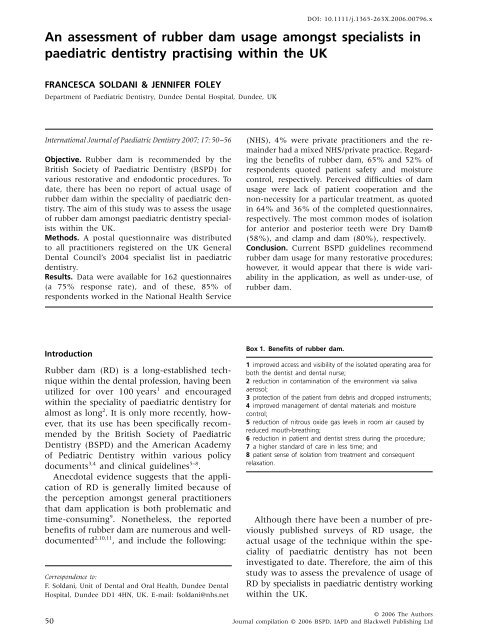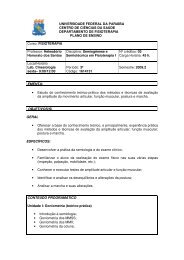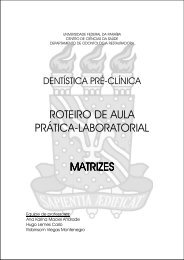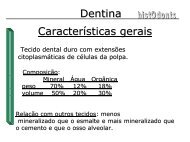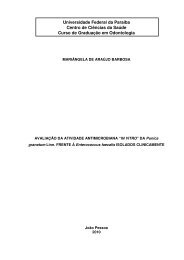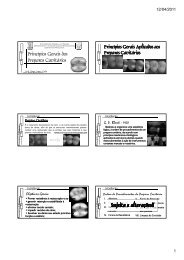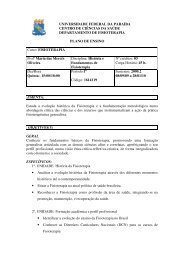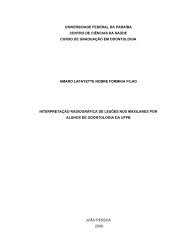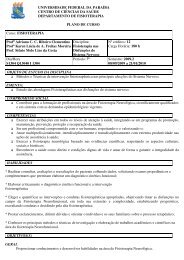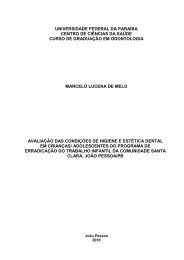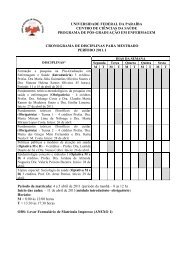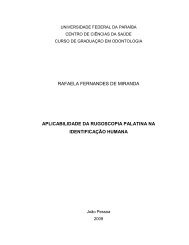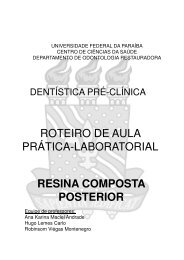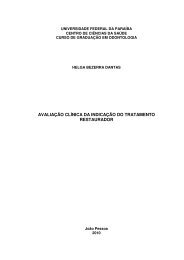An assessment of rubber dam usage amongst specialists in ... - CCS
An assessment of rubber dam usage amongst specialists in ... - CCS
An assessment of rubber dam usage amongst specialists in ... - CCS
You also want an ePaper? Increase the reach of your titles
YUMPU automatically turns print PDFs into web optimized ePapers that Google loves.
DOI: 10.1111/j.1365-263X.2006.00796.x<br />
Blackwell Publish<strong>in</strong>g Ltd<br />
<strong>An</strong> <strong>assessment</strong> <strong>of</strong> <strong>rubber</strong> <strong>dam</strong> <strong>usage</strong> <strong>amongst</strong> <strong>specialists</strong> <strong>in</strong><br />
paediatric dentistry practis<strong>in</strong>g with<strong>in</strong> the UK<br />
FRANCESCA SOLDANI & JENNIFER FOLEY<br />
Department <strong>of</strong> Paediatric Dentistry, Dundee Dental Hospital, Dundee, UK<br />
International Journal <strong>of</strong> Paediatric Dentistry 2007; 17: 50–56<br />
Objective. Rubber <strong>dam</strong> is recommended by the<br />
British Society <strong>of</strong> Paediatric Dentistry (BSPD) for<br />
various restorative and endodontic procedures. To<br />
date, there has been no report <strong>of</strong> actual <strong>usage</strong> <strong>of</strong><br />
<strong>rubber</strong> <strong>dam</strong> with<strong>in</strong> the speciality <strong>of</strong> paediatric dentistry.<br />
The aim <strong>of</strong> this study was to assess the <strong>usage</strong><br />
<strong>of</strong> <strong>rubber</strong> <strong>dam</strong> <strong>amongst</strong> paediatric dentistry <strong>specialists</strong><br />
with<strong>in</strong> the UK.<br />
Methods. A postal questionnaire was distributed<br />
to all practitioners registered on the UK General<br />
Dental Council’s 2004 specialist list <strong>in</strong> paediatric<br />
dentistry.<br />
Results. Data were available for 162 questionnaires<br />
(a 75% response rate), and <strong>of</strong> these, 85% <strong>of</strong><br />
respondents worked <strong>in</strong> the National Health Service<br />
(NHS), 4% were private practitioners and the rema<strong>in</strong>der<br />
had a mixed NHS/private practice. Regard<strong>in</strong>g<br />
the benefits <strong>of</strong> <strong>rubber</strong> <strong>dam</strong>, 65% and 52% <strong>of</strong><br />
respondents quoted patient safety and moisture<br />
control, respectively. Perceived difficulties <strong>of</strong> <strong>dam</strong><br />
<strong>usage</strong> were lack <strong>of</strong> patient cooperation and the<br />
non-necessity for a particular treatment, as quoted<br />
<strong>in</strong> 64% and 36% <strong>of</strong> the completed questionnaires,<br />
respectively. The most common modes <strong>of</strong> isolation<br />
for anterior and posterior teeth were Dry Dam®<br />
(58%), and clamp and <strong>dam</strong> (80%), respectively.<br />
Conclusion. Current BSPD guidel<strong>in</strong>es recommend<br />
<strong>rubber</strong> <strong>dam</strong> <strong>usage</strong> for many restorative procedures;<br />
however, it would appear that there is wide variability<br />
<strong>in</strong> the application, as well as under-use, <strong>of</strong><br />
<strong>rubber</strong> <strong>dam</strong>.<br />
Introduction<br />
Rubber <strong>dam</strong> (RD) is a long-established technique<br />
with<strong>in</strong> the dental pr<strong>of</strong>ession, hav<strong>in</strong>g been<br />
utilized for over 100 years 1 and encouraged<br />
with<strong>in</strong> the speciality <strong>of</strong> paediatric dentistry for<br />
almost as long 2 . It is only more recently, however,<br />
that its use has been specifically recommended<br />
by the British Society <strong>of</strong> Paediatric<br />
Dentistry (BSPD) and the American Academy<br />
<strong>of</strong> Pediatric Dentistry with<strong>in</strong> various policy<br />
documents 3,4 and cl<strong>in</strong>ical guidel<strong>in</strong>es 5–8 .<br />
<strong>An</strong>ecdotal evidence suggests that the application<br />
<strong>of</strong> RD is generally limited because <strong>of</strong><br />
the perception <strong>amongst</strong> general practitioners<br />
that <strong>dam</strong> application is both problematic and<br />
time-consum<strong>in</strong>g 9 . Nonetheless, the reported<br />
benefits <strong>of</strong> <strong>rubber</strong> <strong>dam</strong> are numerous and welldocumented<br />
2,10,11 , and <strong>in</strong>clude the follow<strong>in</strong>g:<br />
Correspondence to:<br />
F. Soldani, Unit <strong>of</strong> Dental and Oral Health, Dundee Dental<br />
Hospital, Dundee DD1 4HN, UK. E-mail: fsoldani@nhs.net<br />
Box 1. Benefits <strong>of</strong> <strong>rubber</strong> <strong>dam</strong>.<br />
1 improved access and visibility <strong>of</strong> the isolated operat<strong>in</strong>g area for<br />
both the dentist and dental nurse;<br />
2 reduction <strong>in</strong> contam<strong>in</strong>ation <strong>of</strong> the environment via saliva<br />
aerosol;<br />
3 protection <strong>of</strong> the patient from debris and dropped <strong>in</strong>struments;<br />
4 improved management <strong>of</strong> dental materials and moisture<br />
control;<br />
5 reduction <strong>of</strong> nitrous oxide gas levels <strong>in</strong> room air caused by<br />
reduced mouth-breath<strong>in</strong>g;<br />
6 reduction <strong>in</strong> patient and dentist stress dur<strong>in</strong>g the procedure;<br />
7 a higher standard <strong>of</strong> care <strong>in</strong> less time; and<br />
8 patient sense <strong>of</strong> isolation from treatment and consequent<br />
relaxation.<br />
Although there have been a number <strong>of</strong> previously<br />
published surveys <strong>of</strong> RD <strong>usage</strong>, the<br />
actual <strong>usage</strong> <strong>of</strong> the technique with<strong>in</strong> the speciality<br />
<strong>of</strong> paediatric dentistry has not been<br />
<strong>in</strong>vestigated to date. Therefore, the aim <strong>of</strong> this<br />
study was to assess the prevalence <strong>of</strong> <strong>usage</strong> <strong>of</strong><br />
RD by <strong>specialists</strong> <strong>in</strong> paediatric dentistry work<strong>in</strong>g<br />
with<strong>in</strong> the UK.<br />
© 2006 The Authors<br />
50 Journal compilation © 2006 BSPD, IAPD and Blackwell Publish<strong>in</strong>g Ltd
Rubber <strong>dam</strong> <strong>usage</strong> <strong>amongst</strong> <strong>specialists</strong> 51<br />
Subjects and methods<br />
This was a prospective questionnaire-based<br />
study modelled on Dillman’s pr<strong>in</strong>ciples 12 . A pilot<br />
study was completed with subsequent m<strong>in</strong>or<br />
modifications to the questions. Number-coded,<br />
modified questionnaires were pr<strong>in</strong>ted on A3<br />
sheets, folded <strong>in</strong>to four-page, A4-sized booklets,<br />
copies <strong>of</strong> which are available from the authors<br />
on request. They were accompanied by a cover<strong>in</strong>g<br />
letter and a prepaid, self-addressed envelope,<br />
and were distributed <strong>in</strong> February 2005 to<br />
all 215 UK resident <strong>specialists</strong> registered on<br />
the 2004 General Dental Council’s specialist list<br />
<strong>in</strong> paediatric dentistry. Those unable to respond<br />
to the <strong>in</strong>itial questionnaire were followed up<br />
with a second mail-shot 6 weeks later. All<br />
responses were anonymous and confidential.<br />
The questions are summarized as follows:<br />
Box 2. Questionnaire sent to UK resident <strong>specialists</strong>.<br />
1 demographic characteristics, <strong>in</strong>clud<strong>in</strong>g qualifications, age and<br />
gender;<br />
2 use <strong>of</strong> RD for various restorative procedures, with a dist<strong>in</strong>ction<br />
between rout<strong>in</strong>e treatment and that carried out under <strong>in</strong>halation<br />
sedation (IHS) and dental general anaesthetic (DGA) (e.g. ‘How<br />
<strong>of</strong>ten do you use <strong>rubber</strong> <strong>dam</strong>, where possible, for the follow<strong>in</strong>g<br />
<strong>in</strong>dividual procedures?’); the possible responses were ‘always’,<br />
‘almost always’, ‘regularly’, ‘rarely’ and ‘never’;<br />
3 perceived benefits and barriers <strong>of</strong> RD use (e.g. ‘What do you<br />
feel are the ma<strong>in</strong> benefits <strong>of</strong> <strong>rubber</strong> <strong>dam</strong>?’/‘What do you feel are<br />
the ma<strong>in</strong> reasons that prevent you from us<strong>in</strong>g <strong>rubber</strong> <strong>dam</strong>?’);<br />
4 Differ<strong>in</strong>g methods <strong>of</strong> RD placement for anterior and posterior<br />
teeth (e.g. ‘If you do use <strong>rubber</strong> <strong>dam</strong> <strong>in</strong> your cl<strong>in</strong>ical practice for<br />
anterior/posterior teeth, how do you use it?’); and<br />
5 Use <strong>of</strong> local anaesthetic if us<strong>in</strong>g RD clamps.<br />
The majority <strong>of</strong> respondents were females<br />
(n = 95, 64%), and almost half <strong>of</strong> respondents<br />
were aged between 41 and 50 years <strong>of</strong> age<br />
(n = 67, 45%). Most respondents worked with<strong>in</strong><br />
the National Health Service (NHS) (n = 126,<br />
85%), with the rema<strong>in</strong>der <strong>in</strong> private practice<br />
(4%) or mixed practice (9%).<br />
Operator factors related to the frequency <strong>of</strong><br />
reported RD <strong>usage</strong> would suggest the follow<strong>in</strong>g:<br />
it is most commonly used <strong>in</strong> the 31–40-yearold<br />
age group (31–40 years = 61%; 41–50<br />
years = 46%; 51–60 years = 34%; > 60 years<br />
= 52%); there is m<strong>in</strong>imal difference <strong>in</strong> RD<br />
<strong>usage</strong> between the sexes (overall <strong>rubber</strong> <strong>dam</strong><br />
<strong>usage</strong>: males = 44%, females = 48%); fixedterm<br />
tra<strong>in</strong><strong>in</strong>g agreement specialist registrars<br />
report the highest use <strong>of</strong> RD, with community<br />
dental <strong>of</strong>ficers report<strong>in</strong>g the lowest <strong>usage</strong><br />
(Fig. 1); and those based <strong>in</strong> private practice<br />
report RD use more than those with<strong>in</strong> the NHS<br />
or mixed practice (private practice = 68%;<br />
mixed practice = 55%; NHS = 45%).<br />
Composite was the most commonly reported<br />
restoration to be placed under RD, with fissure<br />
sealant the least likely; however, where <strong>rubber</strong><br />
<strong>dam</strong> was placed under general anaesthetic, its<br />
use for fissure sealants and glass ionomer<br />
restorations <strong>in</strong>creased (χ 2 = 49.93, P = 0.001<br />
d.f. = 2, and χ 2 = 11.69, P = 0.003, d.f. = 2, respectively)<br />
(Fig. 2). With regard to endodontic<br />
procedures, permanent tooth endodontics were<br />
more likely to be carried out under RD than<br />
primary tooth endodontics (χ 2 = 77.28, P = 0.001,<br />
Data analysis was completed via a cod<strong>in</strong>g system<br />
and the data entered twice <strong>in</strong>to the SPSS Data<br />
Entry© computer program (SPSS Inc., Chicago,<br />
IL, USA) to ensure accuracy prior to f<strong>in</strong>al analysis,<br />
which consisted <strong>of</strong> simple frequencies and<br />
cross-tabulation. Where appropriate, chi-square<br />
analysis was completed and P-values generated.<br />
Results<br />
In total, 162 questionnaires were returned, a<br />
response rate <strong>of</strong> 75%. Overall, 13 respondents<br />
(8%) were no longer <strong>in</strong>volved <strong>in</strong> cl<strong>in</strong>ical paediatric<br />
dentistry, and therefore, were not<br />
<strong>in</strong>cluded <strong>in</strong> the f<strong>in</strong>al data analysis.<br />
Fig. 1. Use <strong>of</strong> <strong>rubber</strong> <strong>dam</strong> <strong>in</strong> relation to position held.<br />
© 2006 The Authors<br />
Journal compilation © 2006 BSPD, IAPD and Blackwell Publish<strong>in</strong>g Ltd
52 F. Soldani & J. Foley<br />
Fig. 2. Use <strong>of</strong> <strong>rubber</strong> <strong>dam</strong> for operative procedures:<br />
*P < 0.01, **P < 0.001.<br />
Fig. 4. Factors prevent<strong>in</strong>g <strong>rubber</strong> <strong>dam</strong> use.<br />
Fig. 3. Use <strong>of</strong> <strong>rubber</strong> <strong>dam</strong> for endodontic treatments:<br />
**P < 0.001.<br />
5 d.f.); however, <strong>dam</strong> use for permanent<br />
endodontics decreased under general anaesthetic<br />
(χ 2 = 20.46, P = 0.001, 2 d.f.) (Fig. 3).<br />
Two respondents stated that they no longer<br />
used amalgam and six respondents no longer<br />
used glass ionomer <strong>in</strong> their practice. These<br />
numbers may underestimate this f<strong>in</strong>d<strong>in</strong>g s<strong>in</strong>ce<br />
there was no specific box for respondents to<br />
complete should they not carry out a particular<br />
restorative treatment.<br />
Concern<strong>in</strong>g mode <strong>of</strong> treatment for all forms<br />
<strong>of</strong> restorative care, RD <strong>usage</strong> was reported as<br />
regular, almost always or always <strong>in</strong> 46% <strong>of</strong><br />
non-sedation cases, 46% <strong>of</strong> IHS cases and 49%<br />
<strong>of</strong> DGA cases, and this was not statistically<br />
significant. These figures do take <strong>in</strong>to account<br />
those respondents who reported not carry<strong>in</strong>g<br />
out a particular treatment or sedation/general<br />
anaesthesia.<br />
Regard<strong>in</strong>g issues prevent<strong>in</strong>g cl<strong>in</strong>icians us<strong>in</strong>g<br />
RD, the most commonly cited reason was <strong>of</strong><br />
Fig. 5. Benefits <strong>of</strong> <strong>rubber</strong> <strong>dam</strong> use.<br />
lack <strong>of</strong> patient cooperation (Fig. 4). The most<br />
beneficial aspect <strong>of</strong> RD was deemed to be<br />
assurance <strong>of</strong> patient safety (Fig. 5).<br />
The most common form <strong>of</strong> RD isolation for<br />
anterior teeth was Dry Dam® (Svenska Dental<br />
Instruments AB, Upplands Väsby, Sweden)<br />
(58%) reta<strong>in</strong>ed with Wedgets® (Hygenic Corporation,<br />
Akron, OH, USA), wooden wedgets<br />
or with no form <strong>of</strong> <strong>in</strong>terproximal device.<br />
Posterior teeth were most commonly isolated<br />
with a clamp and <strong>dam</strong> (80%).<br />
In total, 132 respondents (89%) reported<br />
us<strong>in</strong>g a RD clamp regularly for RD retention,<br />
and 72% <strong>of</strong> these respondents reported us<strong>in</strong>g<br />
local anaesthetic for the procedure whether or<br />
not the tooth was vital.<br />
F<strong>in</strong>ally, a comments box was provided at the<br />
end <strong>of</strong> each questionnaire with vary<strong>in</strong>g op<strong>in</strong>ions<br />
regard<strong>in</strong>g RD use and some <strong>of</strong> the responses<br />
are given <strong>in</strong> Table 1.<br />
© 2006 The Authors<br />
Journal compilation © 2006 BSPD, IAPD and Blackwell Publish<strong>in</strong>g Ltd
Rubber <strong>dam</strong> <strong>usage</strong> <strong>amongst</strong> <strong>specialists</strong> 53<br />
Table 1. Samples <strong>of</strong> respondents’ comments.<br />
Not <strong>in</strong> favour <strong>of</strong> <strong>rubber</strong> <strong>dam</strong><br />
‘I treat most <strong>of</strong> my patients with <strong>in</strong>halation sedation … Improved<br />
cooperation makes it easier to achieve excellent isolation for teeth’<br />
‘Poor patient compliance <strong>in</strong> primary care sett<strong>in</strong>g − I have always<br />
found patients (or parents) accept it better <strong>in</strong> a dental hospital<br />
environment, rather than <strong>in</strong> a community cl<strong>in</strong>ic’<br />
‘I see my sealants, which have been place <strong>in</strong> some <strong>in</strong>stances<br />
10 years ago, and therefore, do not believe <strong>rubber</strong> <strong>dam</strong> would<br />
add any extra benefits … This does take a lot <strong>of</strong> experience/<br />
expertise though’<br />
In favour <strong>of</strong> <strong>rubber</strong> <strong>dam</strong><br />
‘Can potentiate effect <strong>of</strong> relative analgesia, which can be helpful<br />
if care taken not to over-sedate’<br />
‘Rubber <strong>dam</strong> is an <strong>in</strong>valuable adjunct to paediatric dentistry. The<br />
reason most dentists can’t use it is because they were taught by<br />
dentists who can’t (and don’t) use it’<br />
‘Quality care for children cannot be achieved without it’<br />
Other comments regard<strong>in</strong>g <strong>rubber</strong> <strong>dam</strong><br />
‘I use <strong>rubber</strong> <strong>dam</strong> fairly <strong>of</strong>ten − I notice parents’/patients’ surprise.<br />
Patient awareness and expectation is a factor and parents are<br />
surprised/shocked that it has not been used for them! Therefore,<br />
better education and overall better standards are needed’<br />
‘Must be regularly taught at all levels, teachers must be seen to<br />
use it at all times’<br />
‘Locally, more equipment, better tra<strong>in</strong>ed nurses to properly assist<br />
its placement’<br />
Discussion<br />
Previous studies have reported various rates <strong>of</strong><br />
RD <strong>usage</strong> 13–16 , and <strong>in</strong> general, these have demonstrated<br />
that there is under-<strong>usage</strong> compared to<br />
current recommendations, a similar f<strong>in</strong>d<strong>in</strong>g to<br />
this study. For example, one survey revealed<br />
that <strong>rubber</strong> <strong>dam</strong> was used <strong>in</strong> 17–19% <strong>of</strong> cases<br />
for restorative treatment, whilst this <strong>in</strong>creased to<br />
62% for endodontic treatment 13 . Furthermore,<br />
it is <strong>in</strong>terest<strong>in</strong>g to note that those work<strong>in</strong>g<br />
with<strong>in</strong> the US Air Force Dental Services used<br />
<strong>rubber</strong> <strong>dam</strong> <strong>in</strong> more cases than their general<br />
and specialist colleagues 14 . In 1990, other<br />
authors work<strong>in</strong>g with<strong>in</strong> the UK reported that<br />
1.4% and 10.9% <strong>of</strong> operative and endodontic<br />
procedures were carried out under RD,<br />
respectively 15 , with the British Endodontic<br />
Society report<strong>in</strong>g that dentists <strong>in</strong> private practice<br />
used <strong>rubber</strong> <strong>dam</strong> more than those <strong>in</strong> NHS<br />
practice 16 . More specifically, <strong>in</strong> relation to paediatric<br />
patients treated with<strong>in</strong> general dental<br />
practice <strong>in</strong> the UK, there would appear to have<br />
been an <strong>in</strong>crease <strong>in</strong> <strong>rubber</strong> <strong>dam</strong> use from 0%<br />
to 9% between 1986 and 1996 17 . It may be<br />
speculated that it is unlikely that the same<br />
f<strong>in</strong>ancial and time constra<strong>in</strong>ts are evident both<br />
with<strong>in</strong> the US forces dental practices and<br />
private practice compared to dentists work<strong>in</strong>g<br />
with<strong>in</strong> general practice. This could perhaps<br />
expla<strong>in</strong> the differences <strong>in</strong> reported <strong>usage</strong> <strong>in</strong><br />
both the above studies and this one between<br />
those <strong>in</strong> salaried posts and private practice<br />
compared with those <strong>in</strong> NHS general practice.<br />
Nonetheless, it would seem that, with<strong>in</strong> various<br />
countries, specialities and methods <strong>of</strong> fund<strong>in</strong>g,<br />
<strong>rubber</strong> <strong>dam</strong> <strong>usage</strong> is not conform<strong>in</strong>g to current<br />
guidel<strong>in</strong>es and recommendations.<br />
The BSPD guidel<strong>in</strong>es recommend <strong>rubber</strong> <strong>dam</strong><br />
isolation ‘wherever possible’ for many procedures<br />
3–6 . Previous workers concluded that<br />
62.6% <strong>of</strong> paediatric dentistry <strong>specialists</strong> reported<br />
‘rout<strong>in</strong>ely’ us<strong>in</strong>g <strong>rubber</strong> <strong>dam</strong> for vital pulpotomies<br />
18 . These authors suggested, however, that<br />
the use <strong>of</strong> the word ‘rout<strong>in</strong>ely’ may have produced<br />
a negative number <strong>of</strong> responses. The results<br />
<strong>of</strong> this study, where respondents were asked how<br />
<strong>of</strong>ten RD was used for primary tooth endodontics,<br />
would suggest a lower figure than this<br />
(they ‘regularly’, ‘almost always’ and ‘always’ use<br />
RD reported <strong>in</strong> 51% <strong>of</strong> non-sedation patients).<br />
In relation to the mode <strong>of</strong> treatment, it was<br />
<strong>in</strong>terest<strong>in</strong>g to note that there was no significant<br />
difference <strong>in</strong> RD <strong>usage</strong> with no sedation,<br />
IHS or DGA. It would seem reasonable to<br />
hypothesize that patient compliance would be<br />
improved and complete patient compliance<br />
would be achieved with IHS and DGA, respectively,<br />
<strong>in</strong> particular. Furthermore, if patient<br />
compliance was no longer an issue and with<br />
this be<strong>in</strong>g the commonest reason cited by<br />
respondents for prevent<strong>in</strong>g use <strong>of</strong> RD, it would<br />
aga<strong>in</strong> seem logical to conclude that RD would<br />
be used more <strong>of</strong>ten <strong>in</strong> such circumstances. This<br />
was not the case, however, although the reasons<br />
for this are unclear. In addition, the authors<br />
note that there was an apparent reduction <strong>in</strong><br />
RD use for permanent tooth endodontics when<br />
carried out under DGA; aga<strong>in</strong>, the reasons for<br />
this are unclear. One possibility is that the<br />
operator assumes that the airway is protected<br />
from <strong>in</strong>halation <strong>of</strong> <strong>in</strong>struments by a throat<br />
pack/laryngeal mask, and hence, that <strong>rubber</strong><br />
<strong>dam</strong> is not required. If the ‘gold standard’ irrigant<br />
solution <strong>of</strong> sodium hypochlorite, however, is<br />
used for irrigation, the authors would argue<br />
that RD would aga<strong>in</strong> be the gold standard to<br />
protect the s<strong>of</strong>t tissues from potential chemical<br />
<strong>dam</strong>age. In relation to IHS and staff safety, RD<br />
© 2006 The Authors<br />
Journal compilation © 2006 BSPD, IAPD and Blackwell Publish<strong>in</strong>g Ltd
54 F. Soldani & J. Foley<br />
can reduce nitrous oxide gas levels <strong>in</strong> room air<br />
by reduc<strong>in</strong>g patient mouth-breath<strong>in</strong>g 10 , and<br />
therefore, its use is thoroughly recommended<br />
dur<strong>in</strong>g restorative IHS procedures.<br />
The apparent need for RD use to produce<br />
high-quality dentistry has been referred to <strong>in</strong><br />
previous publications 11,13 , with those practitioners<br />
who have received tra<strong>in</strong><strong>in</strong>g <strong>in</strong> the<br />
placement <strong>of</strong> <strong>rubber</strong> <strong>dam</strong> comment<strong>in</strong>g on an<br />
improvement <strong>in</strong> the quality <strong>of</strong> their treatment 13 .<br />
Some studies, however, have revealed no<br />
cl<strong>in</strong>ical difference between techniques (namely<br />
RD compared to cotton wool and high-volume<br />
aspiration) <strong>in</strong> relation to both the longevity<br />
and appearance <strong>of</strong> the restorations 19,20 , and the<br />
retention <strong>of</strong> fissure sealants 20 . Other papers<br />
have reported <strong>in</strong>creased shear bond strength 22<br />
and reduced microleakage 23 <strong>of</strong> composite<br />
when us<strong>in</strong>g RD, although these studies only<br />
had a 2-week post-restoration placement<br />
follow-up. One study reported higher success<br />
rates for fissure sealants placed with cottonwool<br />
isolation compared to RD 24 . Based on the<br />
current available evidence and until further<br />
randomized controlled trials are available with<br />
long-term follow-up, the issue <strong>of</strong> improved<br />
quality with RD appears to be ambiguous.<br />
Numerous benefits <strong>of</strong> RD have been documented<br />
<strong>in</strong> the literature 2,8,11 . In this survey,<br />
improved patient safety was quoted by the<br />
respondents to be the greatest benefit <strong>of</strong> RD<br />
<strong>usage</strong>. This f<strong>in</strong>d<strong>in</strong>g is reassur<strong>in</strong>g given that<br />
previous papers have reported the consequences<br />
<strong>of</strong> not us<strong>in</strong>g RD with regard to <strong>in</strong>haled dental<br />
<strong>in</strong>struments dur<strong>in</strong>g endodontic treatment, an<br />
unfortunate situation that still occurs 25 . Regard<strong>in</strong>g<br />
reduced mercury exposure with the use<br />
<strong>of</strong> RD, the evidence suggests that the effect <strong>of</strong><br />
RD has only m<strong>in</strong>or toxicological relevance 26 .<br />
Improved moisture control was the second<br />
highest ranked benefit, an obvious benefit<br />
because <strong>of</strong> the barrier action <strong>of</strong> a well-placed<br />
RD, which, as one worker described, ‘the<br />
emphasis <strong>in</strong> RD <strong>usage</strong> will, over time, shift from<br />
the current preoccupation <strong>of</strong> the frequency<br />
<strong>of</strong> RD <strong>usage</strong> to the quality and effectiveness<br />
<strong>of</strong> the isolation achieved’ 27 . This study did not<br />
<strong>in</strong>vestigate either the quality or effectiveness<br />
<strong>of</strong> RD isolation reported by respondents,<br />
although the authors may <strong>in</strong>vestigate this<br />
further <strong>in</strong> a prospective cl<strong>in</strong>ical study.<br />
Reduction <strong>of</strong> microbial contam<strong>in</strong>ation was<br />
the third ranked benefit, both for the success<br />
<strong>of</strong> endodontic procedures and also for the<br />
reduction <strong>in</strong> aerosol contam<strong>in</strong>ation <strong>of</strong> the work<strong>in</strong>g<br />
environment. Various papers have shown<br />
previously that atmospheric bacterial contam<strong>in</strong>ation<br />
<strong>in</strong>creases dur<strong>in</strong>g dental procedures 28<br />
and that use <strong>of</strong> RD reduces bacterial air contam<strong>in</strong>ation<br />
by up to 88–98% 29 . This would<br />
suggest a considerable reduction <strong>in</strong> the <strong>in</strong>halation<br />
<strong>of</strong> potentially <strong>in</strong>fective aerosols by dental<br />
personnel when RD is used.<br />
Regard<strong>in</strong>g the types <strong>of</strong> <strong>rubber</strong> <strong>dam</strong> and<br />
methods <strong>of</strong> application used, there have been<br />
multiple previously published descriptions on<br />
this topic, and it is not the objective <strong>of</strong> this<br />
paper to discuss these further. Rubber <strong>dam</strong><br />
clamp placement has been found to be the<br />
aspect <strong>of</strong> <strong>rubber</strong> <strong>dam</strong> application that children<br />
are most concerned about 30 , and although,<br />
realistically, this is the only method to reta<strong>in</strong><br />
<strong>rubber</strong> <strong>dam</strong> when work<strong>in</strong>g on posterior teeth,<br />
it is worthy <strong>of</strong> note that 58% <strong>of</strong> respondents<br />
reported us<strong>in</strong>g Dry Dam® for anterior teeth<br />
with various methods <strong>of</strong> retention that did not<br />
<strong>in</strong>volve a clamp. The authors suspect that this<br />
then precludes the use <strong>of</strong> local anaesthetic,<br />
unless specifically required for the restorative/<br />
endodontic procedure to be completed. Interest<strong>in</strong>gly,<br />
others have found that application <strong>of</strong><br />
EMLA cream allows comfortable <strong>rubber</strong> <strong>dam</strong><br />
clamp placement without the need for local<br />
anaesthetic <strong>in</strong> procedures such as fissure sealant<br />
where local anaesthetic is not necessary 31 . In<br />
relation to fissure sealants, the European Academy<br />
<strong>of</strong> Paediatric Dentistry guidel<strong>in</strong>es state that:<br />
‘The use <strong>of</strong> <strong>rubber</strong> <strong>dam</strong> is obviously the safest<br />
way <strong>of</strong> secur<strong>in</strong>g optimal moisture control,<br />
but <strong>in</strong> young and newly erupted teeth this is<br />
usually not practical s<strong>in</strong>ce it demands the use<br />
<strong>of</strong> local analgesia for placement <strong>of</strong> the clamp.’<br />
In view <strong>of</strong> this and the <strong>in</strong>conclusive evidence<br />
for <strong>rubber</strong> <strong>dam</strong> use, as above, these guidel<strong>in</strong>es<br />
state that ‘the keep<strong>in</strong>g <strong>of</strong> a dry field must<br />
therefore usually be achieved by the use <strong>of</strong><br />
cotton rolls and isolation shields, <strong>in</strong> comb<strong>in</strong>ation<br />
with a thoughtful use <strong>of</strong> the water spray and<br />
evacuation tip’ 32 . A number <strong>of</strong> respondents<br />
<strong>in</strong>dependently stated they would use <strong>rubber</strong><br />
<strong>dam</strong> for fissure sealants as part <strong>of</strong> quadrant<br />
© 2006 The Authors<br />
Journal compilation © 2006 BSPD, IAPD and Blackwell Publish<strong>in</strong>g Ltd
Rubber <strong>dam</strong> <strong>usage</strong> <strong>amongst</strong> <strong>specialists</strong> 55<br />
dentistry. The low rates <strong>of</strong> <strong>rubber</strong> <strong>dam</strong> <strong>usage</strong><br />
recorded <strong>in</strong> this study may then not be an<br />
accurate estimate <strong>of</strong> <strong>rubber</strong> <strong>dam</strong> <strong>usage</strong> for this<br />
particular treatment.<br />
It was reveal<strong>in</strong>g to f<strong>in</strong>d that, <strong>in</strong> relation to<br />
the barriers <strong>of</strong> RD, lack <strong>of</strong> patient cooperation<br />
was cited by respondents as the ma<strong>in</strong> factor<br />
prevent<strong>in</strong>g RD use, which concurs with previous<br />
results 15 . Other workers have looked at<br />
both operator and patient attitudes towards<br />
RD <strong>in</strong> the paediatric patient, <strong>in</strong> cases where<br />
the operator was an undergraduate 9 . All 100<br />
patients <strong>in</strong> the above study accepted RD, with<br />
79% hav<strong>in</strong>g good acceptance <strong>of</strong> RD and 30%<br />
stat<strong>in</strong>g that they preferred treatment with RD.<br />
Patient anxiety scores recorded revealed low<br />
patient anxiety regard<strong>in</strong>g <strong>rubber</strong> <strong>dam</strong> application.<br />
This would suggest that anxiety is not a<br />
universal barrier to the placement <strong>of</strong> <strong>rubber</strong><br />
<strong>dam</strong> <strong>in</strong> the paediatric patient. Equally, others<br />
have found that six out <strong>of</strong> the 10 paediatric<br />
patients <strong>in</strong>cluded <strong>in</strong> a study with<strong>in</strong> general<br />
practice preferred treatment with RD 30 . The<br />
authors <strong>of</strong> this study, however, have noted<br />
that many <strong>of</strong> the patients referred to a specialist<br />
paediatric dentist, rather than those<br />
treated by undergraduates or general dental<br />
practitioners, are secondary/tertiary referrals,<br />
those with severe dental phobia, those with<br />
learn<strong>in</strong>g difficulties or perhaps patients for<br />
whom RD is contra<strong>in</strong>dicated 33 , <strong>in</strong> which case<br />
the use <strong>of</strong> RD may prove impossible.<br />
Perhaps <strong>of</strong> more <strong>in</strong>terest, however, was that<br />
36% <strong>of</strong> respondents stated that they ‘do not<br />
feel that RD is necessary for most treatments’.<br />
As long ago as 1962, Ireland was aware <strong>of</strong> this<br />
view <strong>of</strong> <strong>rubber</strong> <strong>dam</strong>, stat<strong>in</strong>g that:<br />
‘No other technique, treatment or <strong>in</strong>strument<br />
used <strong>in</strong> dentistry is so universally advocated<br />
by the recognized authorities and so universally<br />
ignored by the practic<strong>in</strong>g dentist.’ 34<br />
Indeed, more recent reports have stated that<br />
many <strong>of</strong> the carers who accompany young<br />
patients for treatment have not seen RD previously<br />
9 , suggest<strong>in</strong>g under-use <strong>of</strong> <strong>rubber</strong> <strong>dam</strong><br />
with<strong>in</strong> the pr<strong>of</strong>ession generally, which was reflected<br />
<strong>in</strong> the respondent comments <strong>in</strong> this study.<br />
Lack <strong>of</strong> personal experience was referred to by<br />
8% <strong>of</strong> respondents as a factor prevent<strong>in</strong>g RD use.<br />
Not surpris<strong>in</strong>gly, Wolcott and Goodman found<br />
that dentists who used RD more frequently<br />
encountered fewer patient objections and<br />
came to the conclusion that either the dentists’<br />
motivation to use RD may be reflected by<br />
the presentation <strong>of</strong> RD to patients or dentists<br />
may rationalize their failure to use RD by<br />
claim<strong>in</strong>g patient resistance 35 . The section for<br />
comments cont<strong>in</strong>ued this theme <strong>of</strong> the need<br />
for further experience and tra<strong>in</strong><strong>in</strong>g <strong>in</strong> the use<br />
<strong>of</strong> RD, <strong>in</strong>clud<strong>in</strong>g the need for ‘better tra<strong>in</strong>ed<br />
nurses to properly assist its [<strong>rubber</strong> <strong>dam</strong>]<br />
placement’, this f<strong>in</strong>d<strong>in</strong>g hav<strong>in</strong>g been previously<br />
noted by other workers 11,30 . Whilst there are<br />
currently various options for tra<strong>in</strong><strong>in</strong>g <strong>in</strong> <strong>rubber</strong><br />
<strong>dam</strong> <strong>usage</strong> with<strong>in</strong> the UK, further educational<br />
opportunities are perhaps required both for<br />
dentists and dental care pr<strong>of</strong>essionals.<br />
What this paper adds<br />
• This questionnaire-based study suggests that there is<br />
under-<strong>usage</strong> <strong>of</strong> <strong>rubber</strong> <strong>dam</strong> by paediatric dentistry<br />
<strong>specialists</strong> <strong>in</strong> the UK, as compared to the suggested level<br />
<strong>of</strong> use <strong>of</strong> <strong>rubber</strong> <strong>dam</strong>, endorsed by the BSPD, for<br />
various restorative and endodontic procedures.<br />
• Respondents have highlighted the need for further<br />
tra<strong>in</strong><strong>in</strong>g <strong>in</strong> the practical application <strong>of</strong> <strong>rubber</strong> <strong>dam</strong>.<br />
• Dry Dam® is the most commonly used method for<br />
anterior teeth, as compared to clamp and <strong>dam</strong> for<br />
posterior teeth.<br />
Why this paper is important to paediatric dentists<br />
• This study has raised awareness <strong>amongst</strong> practitioners<br />
<strong>of</strong> the discrepancies <strong>in</strong> their <strong>rubber</strong> <strong>dam</strong> <strong>usage</strong>.<br />
• The paper highlights the need for further educational<br />
opportunities for <strong>rubber</strong> <strong>dam</strong> placement <strong>amongst</strong> the<br />
dental team.<br />
Conclusions<br />
Current BSPD guidel<strong>in</strong>es recommend <strong>rubber</strong><br />
<strong>dam</strong> <strong>usage</strong> for many restorative procedures and<br />
it would appear that there is wide variability<br />
<strong>in</strong> <strong>dam</strong> <strong>usage</strong> <strong>amongst</strong> <strong>specialists</strong> <strong>in</strong> paediatric<br />
dentistry work<strong>in</strong>g <strong>in</strong> the UK. Respondents<br />
cited a lack <strong>of</strong> patient cooperation as the most<br />
common factor prevent<strong>in</strong>g them from us<strong>in</strong>g<br />
<strong>rubber</strong> <strong>dam</strong>, with patient safety rated as the<br />
greatest benefit <strong>of</strong> <strong>rubber</strong> <strong>dam</strong>.<br />
Acknowledgements<br />
We would like to thank those <strong>in</strong>dividuals who<br />
were <strong>in</strong>volved <strong>in</strong> both the pilot study and the<br />
© 2006 The Authors<br />
Journal compilation © 2006 BSPD, IAPD and Blackwell Publish<strong>in</strong>g Ltd
56 F. Soldani & J. Foley<br />
subsequent questionnaire, and also Janet Davies<br />
for her advice regard<strong>in</strong>g data analysis.<br />
This study was funded by the Tattersall Scholarship,<br />
University <strong>of</strong> Dundee, Dundee, UK.<br />
Part <strong>of</strong> this study was previously presented at<br />
the 2005 British Society <strong>of</strong> Paediatric Dentistry<br />
<strong>An</strong>nual Scientific Meet<strong>in</strong>g, Cardiff, UK.<br />
References<br />
1 Rule RW. Rubber <strong>dam</strong> − its use and adjustment. Pac<br />
Dent Gas 1931; 39: 541–556.<br />
2 J<strong>in</strong>ks GM. Rubber <strong>dam</strong> technique <strong>in</strong> pedodontics.<br />
Dent Cl<strong>in</strong> North Am 1966: 327–340.<br />
3 Rugg-Gunn AJ, Welbury RR, Toumba J. British Society<br />
<strong>of</strong> Paediatric Dentistry: a policy document on the<br />
use <strong>of</strong> amalgam <strong>in</strong> paediatric dentistry. Int J Paediatr<br />
Dent 2000; 11: 233–238.<br />
4 Fayle SA, Welbury RR, Roberts JF. British Society <strong>of</strong><br />
Paediatric Dentistry: a policy document on management<br />
<strong>of</strong> caries <strong>in</strong> the primary dentition. Int J Paediatr<br />
Dent 2001; 11: 153–157.<br />
5 Mackie IC. UK National Cl<strong>in</strong>ical Guidel<strong>in</strong>es <strong>in</strong> Paediatric<br />
Dentistry: management and root canal treatment<br />
<strong>of</strong> non-vital immature permanent <strong>in</strong>cisor teeth. Int J<br />
Paediatr Dent 1998; 8: 289–293.<br />
6 Smallridge J. UK National Cl<strong>in</strong>ical Guidel<strong>in</strong>es <strong>in</strong> Paediatric<br />
Dentistry: management <strong>of</strong> the sta<strong>in</strong>ed fissure<br />
<strong>in</strong> the first permanent molar. Int J Paediatr Dent 2000;<br />
10: 79–83.<br />
7 American Academy <strong>of</strong> Pediatric Dentistry. Guidel<strong>in</strong>e<br />
on restorative pediatric dentistry. Paediatr Dent 2005–<br />
2006; 27(7 Reference Manual): 122–129.<br />
8 American Academy <strong>of</strong> Pediatric Dentistry. Guidel<strong>in</strong>e on<br />
pulp therapy for primary and young permanent teeth.<br />
Paediatr Dent 2005–2006; 27(7 Reference Manual):<br />
130–134.<br />
9 Jones C, Reid J. Patient and operator attitudes<br />
towards <strong>rubber</strong> <strong>dam</strong>. J Dent Child 1988; 55: 452–454.<br />
10 Kilpatrick N, Page J, Welbury RR. Operative treatment<br />
<strong>of</strong> dental caries. In: Welbury RR (ed.) Paediatric<br />
Dentistry, 2nd edn. Oxford: Oxford University Press,<br />
2001: 135–156.<br />
11 Christensen GJ. Us<strong>in</strong>g <strong>rubber</strong> <strong>dam</strong> to boost quality,<br />
quantity <strong>of</strong> restorative services. J Am Dent Assoc 1994;<br />
125: 81–82.<br />
12 Dillman DA. Mail and Telephone Surveys: The Total<br />
Design Method. Chichester: John Wiley & Sons, 1978.<br />
13 Joynt RB, Davis EL, Schrier PJ. Rubber <strong>dam</strong> <strong>usage</strong><br />
among practis<strong>in</strong>g dentists. Oper Dent 1989: 14: 176–181.<br />
14 Hagge MS, Pierson WP, Mayhew RB, Cowan RD,<br />
Duke ES. Use <strong>of</strong> <strong>rubber</strong> <strong>dam</strong> among the general<br />
dentists <strong>in</strong> the United States Air Force dental service.<br />
Oper Dent 1984; 9: 122–129.<br />
15 Marshall K, Page J. The use <strong>of</strong> <strong>rubber</strong> <strong>dam</strong> <strong>in</strong> the UK.<br />
A survey. Br Dent J 1990; 169: 286–291.<br />
16 Pitt Ford TR, Stock CJR, Loxley HC, Watson RMG.<br />
A survey <strong>of</strong> endodontics <strong>in</strong> general practice <strong>in</strong> England.<br />
Br Dent J 1983; 154: 222–224.<br />
17 Roshan D, Curzon MEJ, Fairpo CG. Changes <strong>in</strong> dentists’<br />
attitudes and practice <strong>in</strong> paediatric dentistry. Eur<br />
J Paediatr Dent 2003; 4: 21–27.<br />
18 Hunter ML, Hunter B. Vital pulpotomy <strong>in</strong> the primary<br />
dentition: attitudes and practices <strong>of</strong> <strong>specialists</strong><br />
<strong>in</strong> paediatric dentistry practis<strong>in</strong>g <strong>in</strong> the United K<strong>in</strong>gdom.<br />
Int J Paediatr Dent 2003; 13: 246–250.<br />
19 Smales RJ. Effect <strong>of</strong> <strong>rubber</strong> <strong>dam</strong> isolation on restoration<br />
deterioration. Am J Dent 1992; 5: 277–279.<br />
20 Rask<strong>in</strong> A, Sectos JC, Vreven J, Wilson NH. Influence<br />
<strong>of</strong> the isolation method on the 10 year cl<strong>in</strong>ical behaviour<br />
<strong>of</strong> posterior res<strong>in</strong> composite restorations. Cl<strong>in</strong><br />
Oral Invest 2000; 4: 148–152.<br />
21 Albani F, Ballesio I, Campanella V, Marzo G. Pit and<br />
fissure sealants. results at five and ten years. Eur J<br />
Paediatr Dent 2005; 6: 61–65.<br />
22 Barghi N, Knight GT, Berry TG. Compar<strong>in</strong>g two<br />
methods <strong>of</strong> moisture control <strong>in</strong> bond<strong>in</strong>g to enamel:<br />
a cl<strong>in</strong>ical study. Oper Dent 1991; 16: 130–135.<br />
23 Knight GT, Berry TG, Barghi N, Burns TR. Effect <strong>of</strong><br />
two methods <strong>of</strong> moisture control on marg<strong>in</strong>al leakage<br />
between res<strong>in</strong> and composite and etched enamel: a<br />
cl<strong>in</strong>ical study. Int J Prosthodont 1993; 6: 475–479.<br />
24 Lygidakis NA, Oulis KI, Chritodoulidis A. Evaluation<br />
<strong>of</strong> fissure sealants retention follow<strong>in</strong>g four different<br />
isolation and surface preparation techniques. J Cl<strong>in</strong><br />
Pediatr Dent 1994; 19: 23–25.<br />
25 Fishelbrook G, Hook D. Patient safety dur<strong>in</strong>g endodontic<br />
therapy us<strong>in</strong>g current technology: a case<br />
report. J Endod 2003; 29: 683–684.<br />
26 Kremers L, Halbach S, Willruth H, Mehl A, Welzl G,<br />
Wack FX, Hickel R, Greim H. Effect <strong>of</strong> <strong>rubber</strong> <strong>dam</strong><br />
on mercury exposure dur<strong>in</strong>g amalgam removal. Eur<br />
J Oral Sci 1999; 107: 202–207.<br />
27 Liebenberg WH. Secondary retention <strong>of</strong> <strong>rubber</strong> <strong>dam</strong>:<br />
effective control and access considerations. Qu<strong>in</strong>tessence<br />
Int 1995; 26: 243–252.<br />
28 Micik RE. Studies <strong>in</strong> dental aerobiology. I. Bacterial<br />
aerosols generated dur<strong>in</strong>g dental procedures. J Dent<br />
Res 1969; 48: 49–50.<br />
29 Cochran MA, Miller CH, Sheldrake MA. The efficacy<br />
<strong>of</strong> the <strong>rubber</strong> <strong>dam</strong> as a barrier to the spread <strong>of</strong> microorganisms<br />
dur<strong>in</strong>g dental treatment. J Am Dent Assoc<br />
1989; 119: 141–144.<br />
30 Gergely EJ. Rubber <strong>dam</strong> acceptance. Br Dent J 1989;<br />
167: 249–252.<br />
31 Lim S, Julliard K. Evaluat<strong>in</strong>g the efficacy <strong>of</strong> EMLA<br />
topical anaesthetic <strong>in</strong> sealant placement with <strong>rubber</strong><br />
<strong>dam</strong>. Pediatr Dent 2004; 26: 497–500.<br />
32 Welbury R, Raadal M, Lygidakis NA. European Academy<br />
<strong>of</strong> Paediatric Dentistry: EAPD guidel<strong>in</strong>es for the<br />
use <strong>of</strong> pit and fissure sealants. Eur J Paediatr Dent<br />
2004; 5: 179–184.<br />
33 Neiburger EJ. Hazards <strong>of</strong> the <strong>rubber</strong> <strong>dam</strong>. NY State<br />
Dent J 1990; 56: 22–24.<br />
34 Ireland L. Rubber <strong>dam</strong>: its advantages and application.<br />
Texas Dent J 1962; 80: 6.<br />
35 Wolcott RB, Goodman F. A survey <strong>of</strong> <strong>rubber</strong> <strong>dam</strong>:<br />
problems <strong>in</strong> <strong>usage</strong>. J Am Acad Gold Foil Op 1965; 8:<br />
20–25.<br />
© 2006 The Authors<br />
Journal compilation © 2006 BSPD, IAPD and Blackwell Publish<strong>in</strong>g Ltd


